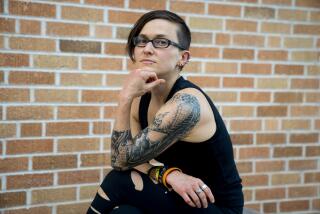Kesey’s jailhouse musings are released
PLEASANT HILL, Ore. — When Ken Kesey was kicked loose after spending the 1967 Summer of Love in jail for a marijuana bust, the guards asked the famous author, psychedelic explorer and prankster if he was going to write a book and include them in it.
“I think so,” Kesey replied.
Two years after the author’s death, “Kesey’s Jail Journal” is out. The book includes two dozen color plates of collages Kesey made from ink drawings entwined with his handwritten reflections laid down in notebooks smuggled out by a buddy who got busted with him.
Looking for something that went beyond the two novels he had already written, Kesey melded words and drawings in a psychedelic 1960s version of an illuminated manuscript that contains echoes of the battle between freedom and authority he described in his most famous book, “One Flew Over the Cuckoo’s Nest.”
“He was trying to make the whole page move, so it would convey something beyond what the words themselves could say,” says his widow, Faye, at the Willamette Valley farm where the family moved after Kesey was released. Perhaps the best stuff never left jail, she says: His last two notebooks were confiscated by guards just before his release.
“Ken had always hoped the other journals would show up,” she says.
In 1967, Kesey was a star of the sex, drugs and rock ‘n’ roll freak show going on around San Francisco. It was five years after publication of “Cuckoo’s Nest,” and three years after his psychedelic bus ride across America, chronicled in “The Electric Kool-Aid Acid Test.”
Kesey’s six-month sentence to the San Mateo County Jail stemmed from a raid on his rural home at La Honda in the Coast Range above Palo Alto, where Kesey and the Merry Pranksters partied with Hells Angels, tried to make sense of the movies they had taken on the bus trip and orchestrated the acid tests that helped turn the world on to LSD.
Kesey was busted along with Page Browning, and together they did their time. Described by Kesey as “a big ex-Shore Patrol Navy man with arms like hawsers and a face like a barnacle [who] made a very valuable backup in the lockup,” Browning kept the journals hidden from guards and smuggled them out in adult magazines.
The duo started out in the lockup, but soon qualified for Sheriff’s Honor Camp, an experimental program where jailbirds who could be trusted spent their time clearing brush in the redwoods not far from Kesey’s home at La Honda and talking about their problems in group therapy sessions.
Ed McClanahan, a writing pal of Kesey’s from Stanford, visited him on Sundays, and McClanahan’s wife gave Kesey the art supplies that he used for the drawings.
“He was a terrific graphic artist,” says McClanahan, who wrote an introduction for the book. “I remember one time we were wandering around downtown Eugene [Ore.] somewhere. We were both pretty thoroughly loaded. He had some artist friend. We wandered into his studio. Ken picks up a scrap of paper. It was an odd shape. He wrote the word ‘space’ on that paper. Then he filled the whole paper up with those letters.”
After his release, Kesey moved his family to the Oregon farm where his wife still lives.
The book languished in the archives of the University of Oregon until about 1995, when Kesey revived it with editor David Sanborn, consolidating characters, smoothing the narrative, and adding a poem before his death in 2001 from cancer.
When Kesey gave the pieces to Sanborn the spring before he died, there was enough to make it something with which Kesey would be happy, Sanborn says.
More to Read
Sign up for our Book Club newsletter
Get the latest news, events and more from the Los Angeles Times Book Club, and help us get L.A. reading and talking.
You may occasionally receive promotional content from the Los Angeles Times.








